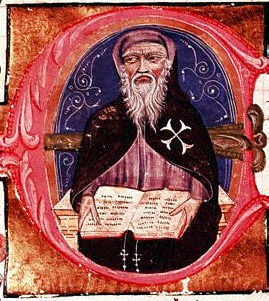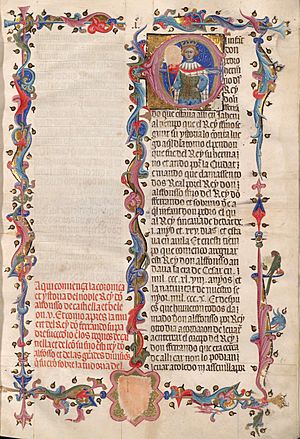Juan Fernández de Heredia facts for kids
Juan Fernández de Heredia (born around 1310 – died 1396) was a Spanish knight from Aragon. He became the Grand Master of the Knights Hospitaller on September 24, 1377, and held this important position until he died. During his time as Grand Master, he tried to gain control of the Principality of Achaea in southern Greece, but he was not successful. Heredia was also very interested in history. He supported the translation and writing of many history books in the Aragonese language. He also advised two Kings of Aragon.
Contents
Early Life and Rise to Power
Juan Fernández de Heredia was born in Munebrega, a town in the Kingdom of Aragon. He joined the Knights Hospitaller in 1328. As a knight, he was in charge of several castles, including Villel, Aliaga, and Alfambra.
He had the support of Peter IV of Aragon, the king, and Pope Innocent VI. With the Pope's help, Heredia was put in charge of important areas of the Hospitaller order in Castile, León, and Saint-Gilles in southern France. The Saint-Gilles area was the richest part of the order.
Heredia supported King Peter IV against a group called the Union of Aragon. He fought alongside the king in the Battle of Epila in 1348, which the king won. In 1346, with the king's help, Heredia became the leader of Amposta, an important area for the Knights Hospitaller in Aragon. He became very powerful and wealthy. Even though another Grand Master, Raymond Berengar, tried to limit his power, Heredia later gained the support of Pope Urban V in 1371. This made him a top leader for the order in Western Europe.
Adventures in Greece
In 1376, Heredia led the ships that took Pope Gregory XI back to Rome. This event was a big step towards ending the time when popes lived in Avignon. The next year, on September 24, Pope Gregory officially made Heredia the Grand Master of the Knights Hospitaller.
Heredia sailed from Naples to Greece in late 1377. He arrived in Vonitsa in April 1378. He immediately tried to capture Arta, but he was captured by Ghin Boua Spata, a local lord. Heredia was then sold to the Ottoman Turks. Luckily, he was quickly set free. He was in Glarentsa by May 20, 1379. While he was captured, his commander, Gaucher of La Bastide, hired a group of soldiers called the Navarrese Company to help in the Principality of Achaea.
After being freed, Heredia went to Rhodes, which was the main base for the Knights Hospitaller. He was given back his power because he supported Pope Clement VII, who was based in Avignon. Heredia tried to make a deal with the Navarrese soldiers. He wanted them to give the castles they held to the Knights Hospitaller. However, the Navarrese asked for too much, so no agreement was made.
Heredia then made a deal directly with Marie of Blois. She claimed the Principality of Achaea for her son, Louis II of Naples. Marie gave her son's rights to the Knights Hospitaller on January 24, 1387, with Pope Clement VII's approval. This deal cost the order 20,000 gold coins. Later, the Pope changed his mind after another person, Amadeus, Lord of Pinerolo, claimed Achaea.
Even with these problems, Heredia continued to use the Navarrese soldiers in his wars. Although King Peter IV had told his Hospitaller knights not to travel with Heredia to the East, Heredia himself claimed rights to the Duchy of Athens. The Navarrese, led by Juan de Urtubia, attacked Thebes, the capital of the duchy. King Peter IV warned Heredia in a letter on September 10, 1380, to stop helping his enemies.
Later Life and Legacy
After April 9, 1382, Juan Fernández de Heredia spent most of his life in Avignon. His power was somewhat reduced by the leaders in Rhodes who did not fully trust him. In April 1383, Pope Urban VI (who was based in Rome and was a rival to Pope Clement VII) appointed Riccardo Caracciolo as an opposing Grand Master. Caracciolo had some support, but his power was not very strong. He died in 1395, and no one replaced him. Heredia died shortly after in 1396 and was followed by Philibert of Naillac as Grand Master.
Heredia was a very rich and educated man. He loved history and supported the translation of many books. He ordered the Chronicle of Morea to be translated into Aragonese before 1393. This book tells about the history of the Morea region in Greece, but it does not mention Heredia's own time there.
The old stone buildings of his castles in Mora de Rubielos and Rubielos de Mora have been studied a lot recently. Juan Fernández de Heredia was buried in Caspe. Sadly, his tomb was destroyed during the Spanish Civil War (1936–1939), but some photographs of it still exist.
Images for kids
| Preceded by Robert de Juilly |
Grand Master of the Knights Hospitaller 1377–1396 |
Succeeded by Philibert de Naillac |
See also
 In Spanish: Juan Fernández de Heredia para niños
In Spanish: Juan Fernández de Heredia para niños




